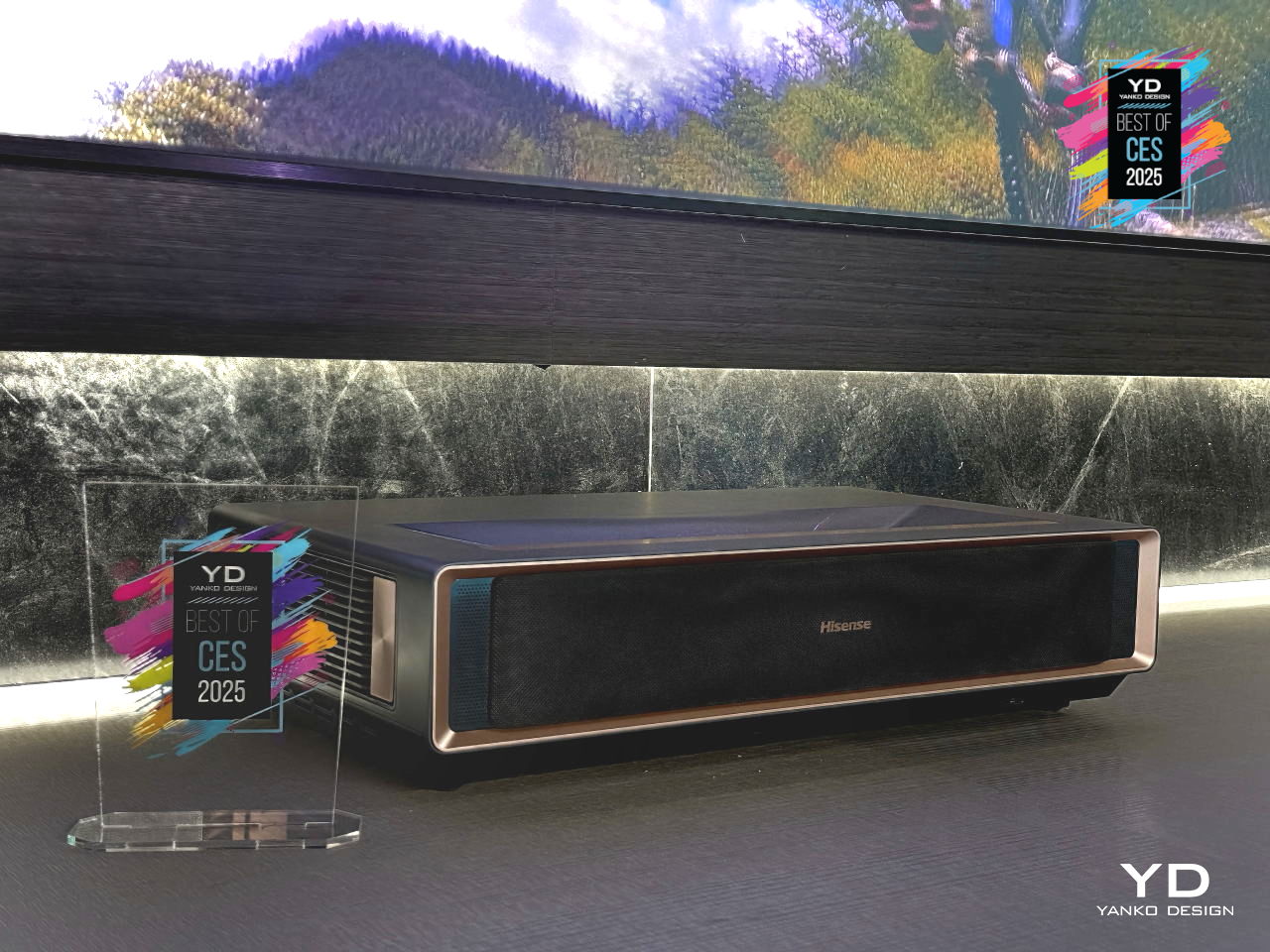Since unveiling the L9Q at CES 2025, Hisense has been collecting awards and turning heads across the tech world. We awarded it our Yanko Design Best of CES 2025 recognition for its breakthrough combination of brightness, design excellence, and real-world usability. Having experienced the L9Q firsthand at CES 2025 earlier this year, we can confirm the excitement is justified. Based on our CES experience and the global launch details, here are the five features that make this laser TV genuinely special.
Designer: Hisense
Update: The L9Q begins shipping in August 2025** with limited-time pre-sale offers including a free HT Saturn sound system or free ALR screen (up to 120 inches) for early buyers.
1. Brightness That Actually Works in Real Rooms (5,000 Lumens)
Most projectors force you to dim the lights or accept washed-out images during daytime viewing. The L9Q flips this dynamic entirely. With 5,000 lumens output, it maintains brilliant image quality even in challenging lighting conditions. During our CES 2025 experience with the unit, the brightness was immediately striking – you could easily mistake it for a traditional TV from the visual impact alone.
When paired with Hisense’s improved Ambient Light Rejection screen featuring 2.9 gain, the system delivers up to 1,500 nits of peak brightness, which surpasses most OLED TVs. To put this in perspective, the previous recommendation for daytime viewing, Epson’s LS800, maxes out at 4,000 lumens. The L9Q represents a 25% jump in raw brightness capability.
What makes this impressive goes beyond the raw numbers. During our hands-on testing at CES, we observed incredibly bold blacks with no blooming, even in well-lit conference rooms. The system maintains contrast while pushing brightness, achieving a technical feat that typically requires trade-offs in other projectors.
2. TriChroma Laser Technology That Redefines Color Accuracy
The L9Q’s triple-laser system delivers a genuine breakthrough, solving fundamental color reproduction problems that plague traditional projectors. The TriChroma engine covers 110% of the BT.2020 color space, up from 107% in the previous L9G model. This expansion means more accurate skin tones, richer landscapes, and colors that match what filmmakers intended.
Unlike single-laser or lamp-based systems that struggle with color saturation at high brightness, the L9Q uses dedicated red, green, and blue lasers working independently. Each laser maintains its color purity while contributing to that 5,000-lumen output. The result is Pantone-certified color accuracy that remains consistent across all brightness levels.
Combined with the 5,000:1 static contrast ratio, reviewers noted colors that “appear much more richer” than previous generations. This technical foundation supports HDR10+, Dolby Vision, and IMAX Enhanced content without the typical brightness versus color trade-offs.
3. Ultra-Short-Throw Design That Actually Fits Your Life
The 0.18:1 throw ratio represents more than just a specification; it fundamentally shifts how projection technology integrates into modern homes. The projector needs just 21 inches from your wall to create a 200-inch image, or can deliver 80 inches from barely 2 inches away. This flexibility has been enhanced with Auto Screen Alignment and Manual Keystone Correction, allowing placement anywhere within two feet of the wall with automatic optimization.
This placement eliminates the shadow interference, cable management nightmares, and installation complexity that keeps families from adopting projector technology. Children can play freely without interrupting movie night. Unlike the previous L9H model’s fixed focal length, the L9Q’s variable focus allows users complete flexibility in screen sizes and distances.
Available in five screen bundles ranging from 100 to 150 inches, the L9Q scales to fit various living spaces rather than demanding dedicated theater rooms. The design refresh features “neat metal finish and sharp rectangular edges” with an Imperial Copper Gilt finish that makes it “much more luxurious looking” than typical projector aesthetics. The iF Design Award recognition validates this premium approach to projector industrial design.
4. Devialet-Tuned Audio That Eliminates External Speaker Needs
Home theater audio typically requires separate speaker systems, receiver units, and complex wiring. The L9Q integrates a complete 6.2.2-channel surround sound system that represents “the first of its kind in a Laser TV.”
The design draws inspiration from Roman amphitheaters, featuring 15-degree tilted speakers that work with Dolby Atmos and DTS Virtual X technologies. This approach goes beyond simply adding speakers; the acoustic engineering creates dimensional soundscapes without requiring ceiling speakers or surround placement.
Devialet’s involvement brings “Opéra de Paris | Devialet edition” tuning expertise to the integrated system. The French audio specialists known for premium hi-fi equipment have calibrated the drivers for both dialogue clarity and environmental immersion. This partnership means cinema-quality audio emerges from the projector itself, simplifying installation while maintaining audiophile standards.
5. Smart Integration That Actually Works Seamlessly
The L9Q runs Google TV instead of Android TV, providing access to “more than 800 free channels, over 10,000 apps” including major streaming services. But the smart features extend beyond content access into practical daily usage.
Wi-Fi 6E connectivity ensures streaming stability, while HDMI 2.1 and eARC support handle gaming and audio equipment integration. Voice control through Google Assistant, plus compatibility with Amazon Alexa and Apple HomeKit means the system responds to natural commands.
Control4 smart home integration positions the L9Q as part of broader home automation rather than an isolated entertainment device. Lighting scenes automatically adjust for movie viewing. Audio systems coordinate seamlessly. The projector becomes one element in an orchestrated smart home experience rather than requiring separate management apps and protocols.
For gaming enthusiasts, 12-millisecond input lag at 2K/120Hz with refresh rates up to 240Hz at lower resolutions delivers competitive gaming performance from a 200-inch screen. The Game Bar overlay provides optimization controls without disrupting gameplay flow.
The L9Q succeeds where other high-end projectors stumble: it adapts advanced display technology to real-world living situations. At $5,999, it positions large-scale home cinema as accessible luxury rather than requiring dedicated theater room investments. These five features work together to transform projection from specialty equipment into practical daily entertainment technology.
Availability and Current Offers: The L9Q begins shipping in August 2025, ending months of anticipation since its CES debut. Early buyers in the U.S. receive either a free HT Saturn sound system or a free ALR screen (up to 120 inches), making the complete home theater package more accessible. The projector’s expanded screen compatibility now supports sizes ranging from 80 to 200 inches, offering unprecedented flexibility for different room configurations. With the new Imperial Copper Gilt finish and iF Design Award recognition, the L9Q positions itself as both cutting-edge technology and luxury statement piece.
The post 5 Signature Features That Make Hisense’s L9Q Laser TV a Game-Changer first appeared on Yanko Design.

